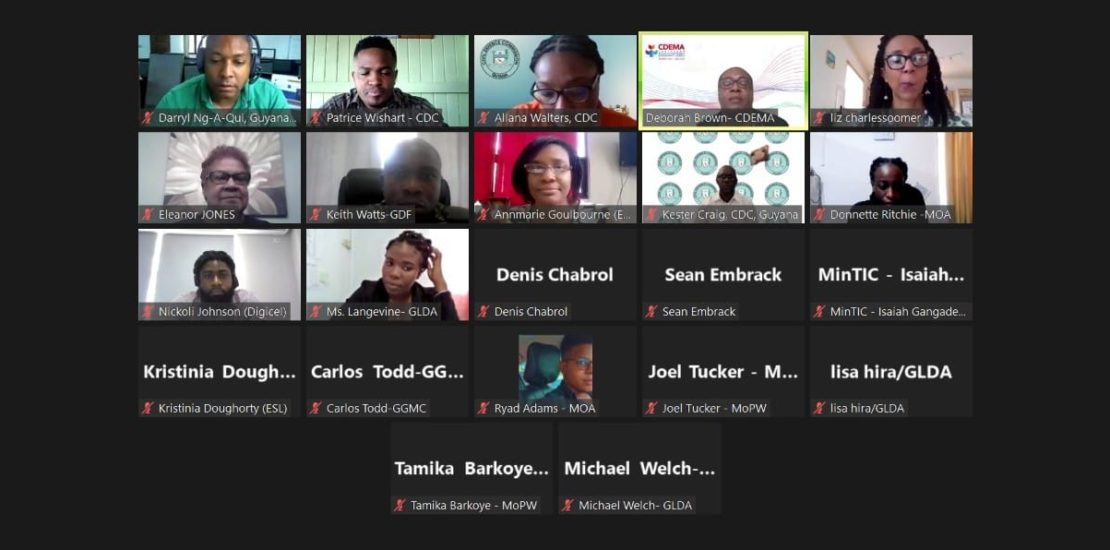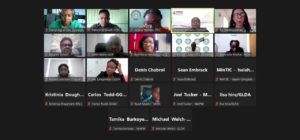- August 6, 2021
- Posted by: Patrice Wishart
- Categories: disaster management, News
No Comments

The Caribbean Disaster Emergency Management Agency (CDEMA), in collaboration with the Civil Defence Commission (CDC) and the United Nations Development Programme (UNDP), yesterday conducted a Workshop to update the Model National Recovery Framework (MNRF) for Guyana. The virtual workshop, led by independent Consultants, saw representatives from the Guyana Defence Force (GDF), Ministry of Agriculture, Guyana Livestock Development Authority, Guyana Geology and Mines Commission, Ministry of Public Works, Ministry of Trade, Industry and Commerce and members of the media.
The MNRF is a comprehensive tool that allows the state to operate efficiently through response and recovery of a disaster or hazard. A few member states of CARICOM have utilized this asset during their time of need and have had favorable results. The framework also highlights shortcomings and gaps and provides alternatives and solutions to allow the country to better handle recovery on a large scale. Caribbean Islands such as St. Vincent and the Grenadines is a recent and prime example.
Director General of the CDC, Lieutenant Colonel Kester Craig, delivered the opening remarks while indicating that he was elated to be involved in the updating of such an important framework. “I’m happy that we are able to update the MNRF for Guyana so that we can ultimately adopt and adapt it.” The Director General also thanked the participants of the workshop saying that he is confident in the strides being made at this juncture.
Ms. Andria Grosvenor, Deputy Executive Director (ag) of CDEMA, then delivered her remarks to the group. Ms. Grosvenor said that such a framework is pivotal for nations to fully recuperate after a catastrophe, and since Guyana is currently enduring unprecedented flooding it is apt to update this model. The acting Deputy Executive Director echoed Lieutenant Colonel Craig’s jubilation at the inclusiveness of the workshop and predicted significant success after the workshop is completed.
Representative of UNDP’s EnGenDer Project, Ms. Elizabeth Charles-Soomer also weighed in on the importance of gender equality during the recovery phase of a disaster or hazard. She spoke about the risks that vulnerable groups and individuals face and how important it is that MNRF caters to these facets.
ESL, the Consultancy Group that spearheaded the update of the MNRF, then made their presentation and findings led by Ms. Eleanor Jones and Ms. Annmarie Goulbourne. The team laid out an elaborate and detailed report highlighting each area of the Model. They addressed legislative, structural, financial and social gaps within the current framework, both at a locally regional level and a national level. For instance, Ms. Goulbourne highlighted the need for financial aid from the government tier by way of a recovery fund for individuals and groups who are particularly at risk in more than one area, such as a single mother whose farm was destroyed by consistent flood waters. The Consultancy Team also received feedback and questions from participants of the workshop in several regards.
Ms. Deborah Brown, a representative from CDEMA’s Recovery Unit, took us through the next steps after MNRF has been updated. She spoke about the expectations in Guyana versus the reality and alluded that such a framework must be ever evolving to meet the needs of the impacted society. An evaluation was also conducted by Ms. Brown with the consensus that those involved in the workshop pledged to ensure that the updated MNRF would be adopted and adapted soonest, so as to properly prepare for future disasters and hazards.
Guyana has had its fair share of impacts over recent years with the most recent being an earthquake in the Rupununi District, and widespread flooding caused by torrential rainfall. It was clear that while Great strides have been made throughout the years there is still a long way to go and the updated MNRF is slated to ensure those upcoming strides are significant and consistently effective.

